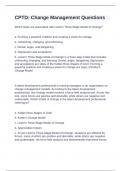CPTD: Change Management Questions
Which steps are associated with Lewin's Three-Stage Model of Change?
a. Forming a powerful coalition and creating a vision for change
b. Unfreezing, changing, and refreezing
c. Denial, anger, and bargaining
d. Depression and acceptance
b. Lewin's Three-Stage Mode of Change is a three-step model that includes
unfreezing, changing, and freezing. Denial, anger, bargaining, depression,
and acceptance are steps of the Kübler-Ross Stages of Grief. Forming a
powerful coalition and creating a vision for change are steps of Kotter's
Change Model.
A talent development professional is training managers in an organization on
change management models. According to the talent development
professional, one change model involves a force field analysis tool. As per this
tool, some forces are positive and desirable, while others are negative and
undesirable. Which model of change is the talent development professional
referring to?
a. Kübler-Ross Stages of Grief
b. Kotter's Change Model
c. Lewin's Three-Stage Model of Change
d. Appreciative Inquiry
c. As per Lewin's Three-Stage Model of Change, situations are affected by
forces, some of which are positive and desirable, while others are negative
and undesirable. His force field analysis tool demonstrates that these forces
, push against each other to maintain a status quo. The other models of change
listed do not have this feature.
Which statement is a part of Kotter's Change Model?
a. The change response cycle phases are denial, anger, bargaining,
depression, and acceptance.
b. Situations are affected by some forces that are positive and desirable and
some that are negative and undesirable.
c. The steps include forming a powerful coalition, creating a vision for change,
communicating the vision, removing obstacles, creating short-term wins,
building on the change, and anchoring the changes.
d. The steps include dealing with tangible and intangible losses, repatterning,
and developing a new identity and experiencing new energy.
c. Kotter's Change Model is initiated with an admonishment to create a sense
of urgency. From there, the steps include forming a powerful coalition,
creating a vision for change, communicating the vision, removing obstacles,
creating short-term wins, building on the change, and anchoring the changes
in corporate culture. Lewin's Three-Stage Model of Change states that
situations are affected by some forces that are positive and desirable and
some that are negative and undesirable. The change response cycle phases
of Kübler-Ross Stages of Grief include denial, anger, bargaining, depression,
and acceptance. The Bridges's Transition Model includes dealing with tangible
and intangible losses, repatterning, and developing a new identity and
experiencing new energy.
The manager of an organization is training team members on various change
management models. One model considers the ending, the neutral zone, and
new beginnings as the three main steps. Which model of change supports
these steps?




